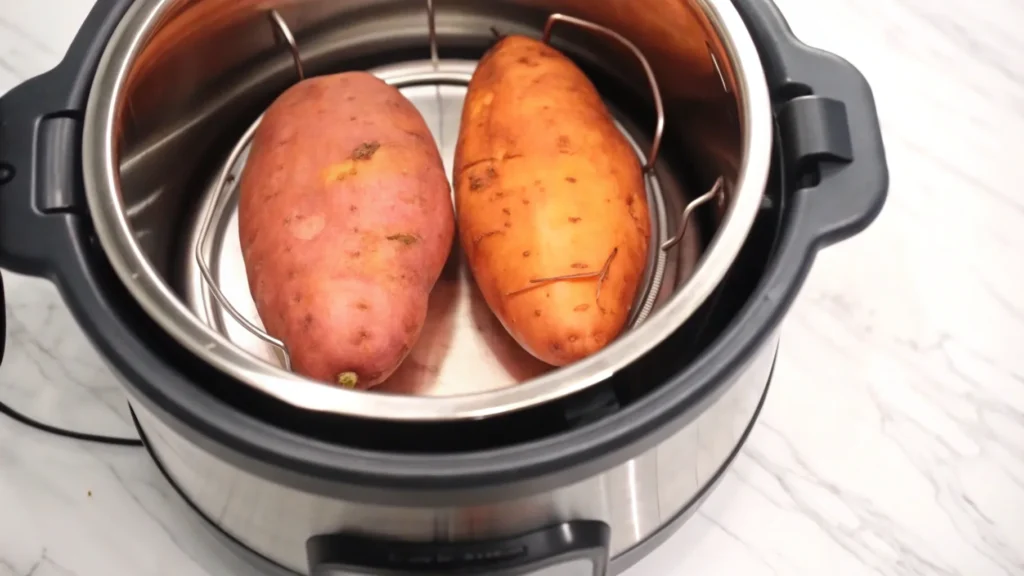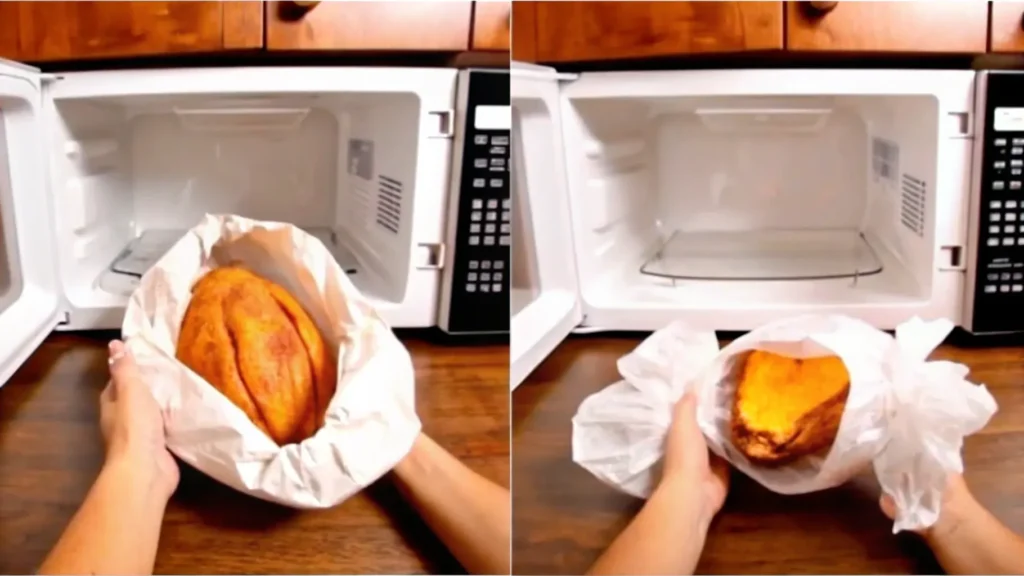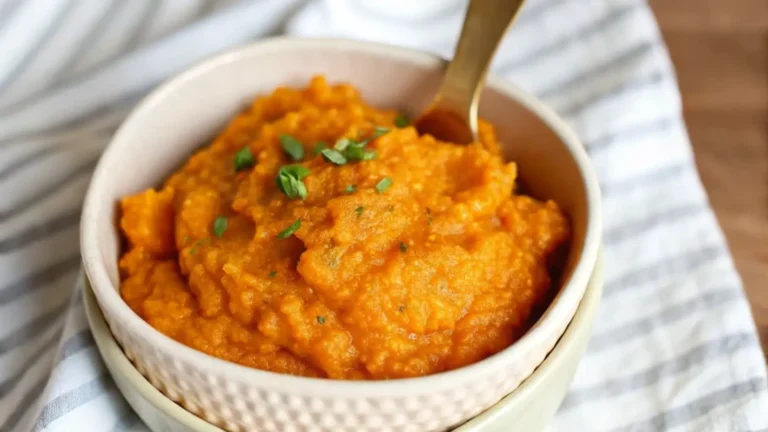Cooking sweet potatoes in the microwave is a quick and convenient way to prepare this versatile root vegetable. But it’s not uncommon to end up with a dried-out, chewy result that’s far from the soft, creamy texture you were expecting. Don’t worry; mastering how to keep sweet potatoes from drying out in the microwave is easier than you might think. This guide dives deep into the why, how, and what to do to make your sweet potatoes perfectly moist and delicious every time. We’ll explore common pitfalls, preparation hacks, cooking methods, and storage tips to ensure your microwaved sweet potatoes come out just right.
Why Do Sweet Potatoes Dry Out in the Microwave?
Understanding the Microwave’s Heating Mechanism
Microwaves cook food by heating water molecules inside it, turning them into steam. Sweet potatoes are naturally rich in water, but the concentrated heat of a microwave can cause moisture to escape rapidly. This dehydration leads to dry, hard textures if not managed properly. Unlike baking in an oven, where heat surrounds the food evenly, microwaves heat in sporadic bursts, sometimes causing uneven moisture loss.
Common Mistakes Leading to Dryness
One major reason sweet potatoes dry out is overcooking. Setting the microwave to maximum power without monitoring can zap all the moisture out of the potato. Forgetting to pierce the skin also creates problems—it traps steam inside, leading to explosions or uneven cooking. Additionally, microwaving sweet potatoes without covering them allows steam to escape, leaving the potato dry and unappetizing.
Per evitare questi problemi, un po’ di preparazione e comprensione del comportamento del tuo microonde possono fare molta strada. Piccole modifiche nella tecnica possono fare un’enorme differenza nell’ottenere una patata dolce tenera e umida. Mentre continuiamo, imparerai consigli pratici per evitare queste insidie dell’essiccazione.
Tecniche di preparazione adeguate
Scegliere le patate dolci giuste
To achieve the best results in the microwave, selecting the right sweet potatoes is crucial. Small to medium-sized sweet potatoes are ideal because they cook more evenly and require less time. Larger sweet potatoes often end up partially uncooked in the center while the edges dry out. Moreover, look for potatoes with smooth skin and no cuts or bruises, as damage can make them lose moisture more quickly.
When choosing, aim for a uniform shape. Oddly shaped sweet potatoes may cook unevenly, leading to dry spots. These small decisions help immensely in learning how to keep sweet potatoes from drying out in the microwave.
Prepping Sweet Potatoes Before Cooking
Preparing your sweet potatoes correctly is the next essential step. Start by thoroughly washing the potatoes under cold water to remove any dirt or debris. After cleaning, dry them with a kitchen towel, but don’t skip this step—moisture on the skin can cause steaming instead of roasting.
Next, use a fork to pierce the sweet potato in several spots. This step prevents pressure buildup, reducing the chances of the potato exploding. Furthermore, these small holes allow steam to escape gradually, helping retain moisture inside.
Using a Damp Paper Towel or Microwave-Safe Cover
Wrapping the sweet potato in a damp paper towel is an excellent trick for locking in moisture. The dampness creates a steaming effect inside the microwave, which helps the potato cook evenly while staying moist. If you prefer, you can use a microwave-safe lid or bowl to cover the sweet potato instead. Both options work to trap steam, which is key in figuring out how to keep sweet potatoes from drying out in the microwave.

Optimal Cooking Methods for Microwaving
Step-by-Step Microwave Cooking Guide
To start, place your prepared sweet potato on a microwave-safe plate. Set the microwave to medium power rather than full power to ensure gradual cooking. Cook the sweet potato for about 5 minutes, flipping it halfway through for even heating. If it’s not tender when you test it with a fork, continue microwaving in 30-second increments.
Using this method not only prevents overcooking but also keeps the potato’s natural moisture locked inside. This is a practical approach to mastering how to keep sweet potatoes from drying out in the microwave.
Adjusting Cook Time Based on Potato Size
Size matters when microwaving sweet potatoes. Smaller potatoes typically cook in 4 to 5 minutes, while medium ones may require up to 7 minutes. For larger potatoes, expect cooking times of 8 to 10 minutes, but always check for doneness.
To test, gently press the potato with a fork or knife. It should feel soft all the way through. If the potato feels hard in the middle, add more time in small increments. Paying attention to size ensures consistency and moisture retention.
Incorporating Steaming for Better Results
If you want even better results, try steaming your sweet potato. Place it in a microwave-safe bowl with a tablespoon of water, then cover the bowl with a microwave-safe plate or lid. The water creates additional steam, which surrounds the sweet potato, preventing it from drying out.
This method is particularly useful for larger sweet potatoes, which may need extra moisture to cook evenly. By combining steaming with proper preparation, you’ll have no trouble understanding how to keep sweet potatoes from drying out in the microwave.
Storing and Reheating Sweet Potatoes

Storing Microwaved Sweet Potatoes Safely
After microwaving, storing sweet potatoes correctly ensures they retain their moisture and flavor. Begin by letting them cool to room temperature. Placing hot sweet potatoes directly in the fridge can cause condensation, which might make them soggy. Once cooled, wrap each sweet potato individually in plastic wrap or place them in an airtight container. This step helps lock in moisture, a critical aspect of mastering how to keep sweet potatoes from drying out in the microwave.
For longer storage, consider freezing. To do this, peel and mash the sweet potatoes, then store them in freezer-safe containers or bags. When reheated, the mashed consistency ensures they remain creamy and delicious.
Reheating Without Losing Moisture
Reheating sweet potatoes can often lead to them drying out, but there are simple tricks to avoid this. Before microwaving a stored sweet potato, sprinkle a few drops of water or cover it with a damp paper towel. This creates a steamy environment, which helps retain its soft texture.
Alternatively, you can reheat sweet potatoes in the oven. Wrap them in aluminum foil and bake at 350°F (175°C) for about 10-15 minutes. This method warms the potato thoroughly without letting moisture escape.
For another potato-centric recipe, explore our guide to perfect potatoes au gratin for a delicious side dish.
FAQs About Microwaving Sweet Potatoes
How Long Should I Microwave a Sweet Potato?
The cooking time depends on the size of the sweet potato. For small ones, 4 to 5 minutes usually suffice. Medium-sized potatoes need about 6 to 7 minutes, while larger ones may require 8 to 10 minutes. Always flip the potato halfway through for even cooking.
Can I Microwave Multiple Sweet Potatoes Together?
Yes, but you’ll need to adjust the cooking time. Add 2 to 3 minutes for each additional potato. To avoid uneven cooking, ensure the sweet potatoes don’t touch each other, allowing heat to circulate around them.
How Do I Prevent My Sweet Potato from Exploding in the Microwave?
Piercing the skin with a fork several times before cooking is key. These small holes let steam escape, preventing pressure buildup that could lead to an explosion.
What’s the Best Way to Ensure Even Cooking?
Even cooking starts with uniform preparation. Choose sweet potatoes of similar size, and rotate them halfway through microwaving. Wrapping them in a damp paper towel can also help distribute heat evenly while preserving moisture.
For more delicious recipes and kitchen tips, visit Larde Recipes.
Common Reasons Why Biscuit Dumplings Fall Apart
Overhandling the Dough
One of the main reasons biscuit dumplings fall apart is overhandling the dough. When the dough is worked too much, it can lose its structure, making it difficult to stay intact during cooking. Instead, mix the ingredients just until combined and avoid kneading excessively. This approach helps maintain the light, tender texture that dumplings are known for.
Additionally, shaping the dough with a gentle touch is crucial. Pressing too hard or rolling too thinly can weaken the dumplings, causing them to disintegrate in the broth. For best results, handle the dough minimally and with care.
Cooking in Boiling Liquid
Another common mistake is cooking the dumplings in liquid that’s boiling too vigorously. High heat can break apart the delicate structure of biscuit dumplings, leaving you with a mushy mess. To avoid this, reduce the heat to a gentle simmer before adding the dumplings. This method ensures they cook evenly without falling apart.
Similarly, avoid stirring the pot too much once the dumplings are in. Excessive movement can also cause them to break. Using a wooden spoon or ladle, gently move the liquid around instead of stirring directly, which helps keep the dumplings intact.
By addressing these common issues, you can master how to keep biscuit dumplings from falling apart, ensuring a perfect texture every time.
Tips for Keeping Biscuit Dumplings Intact
Adding the Right Amount of Liquid
To ensure your dumplings stay together, it’s important to get the consistency of the dough just right. Too much liquid can make the dough sticky and prone to breaking, while too little can make it crumbly. Start by adding small amounts of liquid and mix gently until the dough holds together without being overly wet.
If you’re using a broth or soup base, make sure it’s not too oily. Excess oil can cause the dumplings to slip apart. Skim any visible fat from the liquid before adding your dumplings.
Timing the Cooking Process
Timing plays a key role in keeping biscuit dumplings from falling apart. Add them to the pot only when the broth is ready, as letting them sit in the liquid for too long can make them soggy. Once added, cover the pot and let them cook undisturbed for the first 10 minutes. This allows the dumplings to set before you check on them.
Additionally, testing for doneness with a toothpick or skewer is a gentle way to avoid breaking them during the cooking process. Following these tips ensures your dumplings stay whole and delicious.
By focusing on these techniques, you’ll confidently answer the question, “How do you keep biscuit dumplings from falling apart?” while enjoying perfectly tender results every time.
Common Mistakes to Avoid When Microwaving Sweet Potatoes
Overlooking Proper Preparation
One of the most frequent errors when microwaving sweet potatoes is skipping crucial preparation steps. For example, failing to pierce the skin can result in uneven cooking or even cause the potato to burst due to trapped steam. This step is vital for anyone wanting to learn how to keep sweet potatoes from drying out in the microwave. Additionally, neglecting to wrap the potato in a damp paper towel often leads to dryness, as it allows moisture to escape rapidly.
Another common mistake is not cleaning the sweet potato thoroughly. Residual dirt can affect the cooking process and lead to unpleasant flavors. Always wash and dry the sweet potato before microwaving to ensure the best results.
Using Incorrect Microwave Settings
Many people make the mistake of cooking sweet potatoes on high power throughout the entire process. This approach often results in dry, tough textures, especially on the edges. Instead, use medium power for more even cooking. Setting the correct time is equally important. Overcooking is a primary reason sweet potatoes dry out in the microwave, so check for doneness periodically to avoid this problem.
Placing multiple sweet potatoes too close together in the microwave is another error to avoid. This can create uneven heat distribution, leading to undercooked centers and dried-out edges. Always arrange sweet potatoes with some space between them to ensure even cooking.
Final Tips for Perfect Sweet Potatoes Every Time
Combining Methods for Better Results
For the ultimate balance of texture and flavor, consider combining microwave cooking with other methods. For example, after microwaving, finish the sweet potato in the oven for a few minutes to achieve a crisp skin while keeping the inside moist. This technique is an excellent way to master how to keep sweet potatoes from drying out in the microwave while adding a gourmet touch to your dish.
Another approach is steaming the sweet potato in the microwave. Place the potato in a microwave-safe dish with a small amount of water, then cover it tightly. The added steam helps maintain moisture, making the sweet potato soft and flavorful.
Experimenting with Flavors and Toppings
Once you’ve perfected the cooking process, experiment with different toppings to enhance your sweet potato. Butter, cinnamon, and brown sugar are classic options, but savory choices like sour cream, chives, or even chili can transform your dish. These additions complement the natural sweetness of the potato while adding variety to your meals.
By following these final tips, you’ll consistently enjoy perfectly cooked, moist sweet potatoes. Remember, mastering how to keep sweet potatoes from drying out in the microwave is all about preparation, technique, and a bit of creativity.

